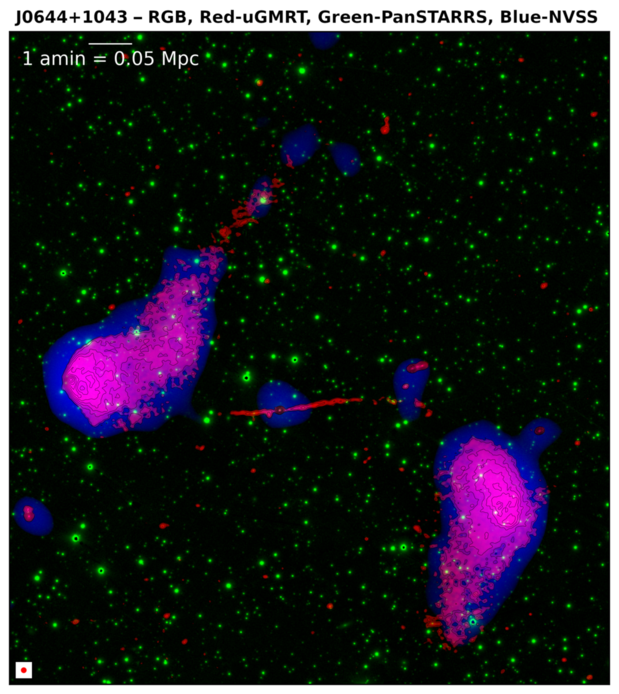Astronomy Object of the Month: October 2024
< previous Archive next >
J0644+1043: A Giant Cosmic Serpent
Highly sensitive radio observations obtained using Giant Metrewave Radio Telescope (GMRT) led to the unusual discovery of a 100 kpc narrow curved twin jet in the S-shaped giant radio galaxy J0644+1043.

Illustration 1:
General structure of the S-shaped giant radio galaxy J0644+1043. The contours and red colour show the broadband 525 MHz radiation obtained using GMRT. The blue coloured structures come from low-resolution
NVSS survey made at 1.4 GHz with the Very Large Array. In the background in green colour there is an optical image (from the PanSTARRS survey). Source: Team publication.
Radio galaxies have been known for seven decades. The widely accepted mechanism for the formation of an extragalactic radio source involves a rotating supermassive black hole surrounded by a disk of accreting matter. From these relatively small objects, called active galactic nuclei, matter, energy, and magnetic field can be transferred through narrow relativistic jets of charged plasma to very large distances, well beyond the size of a given galaxy. A typical radio galaxy is Cygnus A (shown in Figure 1.
Jets in some radio galaxies show, however, significant deviations from their initial direction, leading to the formation of several distorted types, that is, a mirror-symmetric one called C-shape or an inversion-symmetric one called S-shape. The S-shaped curved lines (also known as the serpentine lines) are found all around us and are common in nature, architecture, infrastructure, and human design in general. S-shapes can also be found among astronomical objects. In particular, the recently disclosed radio galaxy J0644+1043 has an unusual S-shape.
New sensitive GMRT low-frequency observation of J0644+1043 revealed thin, collimated radio jets emanating from the radio core and terminating with detached lobes (see Illustration 1). The source has a pronounced hotspot at the edge of the eastern lobe (left side of the illustration). However, the western lobe (right side of the illustration) has an extended plateau instead of a compact hotspot-like feature. Deep GMRT observations also reveal a 100 kiloparsec jet and a counter jet. The jets are not straight but slightly curved toward the lobes. The eastern jet's connection to the lobe is not discernible. The western jet, which can be seen as separate parts and that bends just before the base of the plume, eventually feeds into the western lobe (see Illustration 2). The possible knotlike features are visible on both sides of the radio core. These jets can be considered as "naked jets" because no diffuse cocoon was detected around them. Moreover, such large jets are very rare to observe in radio galaxies.
The overall radio morphology of J0644+1043, estimated to be less than 50 million years old, exhibits an S-shape. Moreover, the clearly visible jets are S-wavy themselves, which leads us to surmise that the central active galactic nucleus that produces the jets precesses roughly in a counter clockwise direction with respect to the sky plane. A number of possible models have been proposed to explain changes in the direction of jet propagation, including a continuous reorientation of the jets due to the presence of another supermassive black hole companion(s) and/or due to a surrounding massive tilted accretion disk.
Dedicated spectroscopic observations revealed the redshift of the host galaxy z = 0.0488. The projected linear size of J0644+1043 from the eastern hotspot to the peak of the western plateau, following the path of the jets, is more than 0.7 Mpc (which corresponds to the distance between M31 and the Milky Way galaxy). Moreover, the optical spectrum indicates that this giant radio galaxy is powered by a supermassive black hole of mass MBH = 4.1 × 108 M⊙.

Illustration 2: The kiloparsec-scale jet of J0644+1043: 650 MHz GMRT thin contours superimposed on the red colored map. As in the first image, blue colour indicates NVSS observations and green colour represents optical data. The EJ1, EJ2,WJ1 and WJ2 mark the jet knots. The synthesized beam size of 5.6" × 4.4" is marked by a filled ellipse in the upper right corner of the image. Source: Team publication.
Original publication: Sethi, S., Kuźmicz, A., Jamrozy, M., Slavcheva-Mihova, L., Discovery of a 100 kpc Narrow Curved Twin Jet in the S-shaped Giant Radio Galaxy J0644+1043, ApJ, 969, 156 (2024).
The research was conducted at the Department of Stellar and Extragalactic Astronomy of the Jagiellonian University’s Astronomical Observatory. The work was carried out thanks to the financial support of the National Science Center through grant UMO-2018/29/B/ST9/01793.
|
Sagar Sethi Astronomical Observatory Jagiellonian University Sagar.Sethi [@] doctoral.uj.edu.pl |


